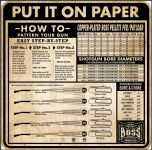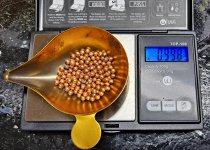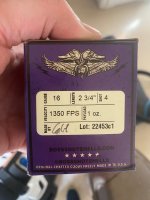TSS is wasted unless your shooting light slow low recoil loads. Like for phez 7/8 oz of 9s at 1000. Some autos probably don't handle them very good but low recoil is the whole point of tss & using small gages for big birds. They shine with doubles & o/u, tried some in my old man's Red Lable & you don't know you were shooting a 12 gauge.
You are using an out of date browser. It may not display this or other websites correctly.
You should upgrade or use an alternative browser.
You should upgrade or use an alternative browser.
Boss shotgun ammunition
- Thread starter Roy B
- Start date
John Singer
Well-known member
Its no myth.. the average hunter cripples the heck out of birds with steel shot because they do not understand the ballistics regarding shot size/velocity and do not pattern their guns. Lead shot is so forgiving that you can do the exact thing and kill birds all day long, however there is no room for error with steel. Just go to any pheasant group on Facebook, which will be full of average joe hunters, and ask how steel shot works. Youll get 200 replies that steel sucks and its nothing but cripples. Most are buying steel 5/6s because they like lead 5/6s and dont understand that there is a ballistic difference.
I have to admit that you have a valid point here. Hunters using 5 & 6 steel for pheasants are using undersized shot for the job, and are likely losing downed birds. Unfortunately this error is exacerbated by manufacturers such as Kent.
Kent Cartridge - High Performance Shotshells for Hunting & Sport Shooting
Kent Cartridge delivers premium shotshell ammunition engineered for waterfowl, upland, and turkey hunting. Trusted by serious hunters for consistent performance, innovation, and non-toxic solutions.
Their Upland Fasteel has an image of pheasant on the box and is only available in 5,6, & 7 sizes.
Years ago, probably one of the most common shells used for pheasants were the cheap lead "Duck and Pheasant" loads of 1 1/4 oz of #4 or #6 lead at about 1250 to 1300. fps.
#2, #3, or #4 steel shot at velocities around 1400 fps through proper chokes are very effective for pheasant at ranges to 35 or 40 yards.
I hunted waterfowl back in the lead shot days and made the transition to nontoxic shot. Lead us not some magical Hammer of Thor that results in zero cripples.
I have often heard people complain "steel sucks", and "more birds are lost with steel than it kills". That is not true for waterfowl and not true for pheasant when when using properly sized shot with proper chokes at appropriate ranges.
Back to the original question that started this thread. I have used used Boss bismuth (as well as Kent, and Hevi Shot bismuth). They all work well. For my hunting, over my dog, I see no advantage over steel.
Last edited:
KEOutdoors
Well-known member
Just an FYI for everyone interested in Boss, they just sent out an email about the 2024 forecast. Due to powder constraints they anticipate ammo shortages and price increases on their products. I ordered a case of 200 that should last for the next couple of years.
They need to raise prices but could donate $30,000 to non profs from sales of one product last month?
Yeah... Is pretty funny when you say it like that. BUT - All companies know what they're going to shell out for donations, marketing, etc. and calculate that into their margins. If they raise their prices to cover the increasing cost of powders, and DON'T continue to donate to non profs, then I'll be raising my eyebrows.They need to raise prices but could donate $30,000 to non profs from sales of one product last month?
I've not shot their 16ga product, but you are correct. The addition of 1/8 oz of shot is a newer thing. It amounts to about 18 pellets.I see Boss is selling 16 gauge 1-1/8 ounce loads at 1240 fps.
Seems to me, the ones I bought a couple years ago are 1 ounce and 1300 fps.
Am I right? Any noticeable difference with these 1-1/8 ounce loads? I'm thinking the #4's would be really, really nice.

A5 Sweet 16
Well-known member
I see Boss is selling 16 gauge 1-1/8 ounce loads at 1240 fps.
Seems to me, the ones I bought a couple years ago are 1 ounce and 1300 fps.
Am I right? Any noticeable difference with these 1-1/8 ounce loads? I'm thinking the #4's would be really, really nice.
I'm pretty sure the 1 oz loads were 1350. The new 1-1/8 oz loads will have about 20 more pellets with very similar effective range (maybe 3.5 yds less). And they'll be roll crimped 2-9/16" long. I'm pretty excited about them. I hope they pattern well in my gun.
KEOutdoors
Well-known member
I've not shot their 16ga product, but you are correct. The addition of 1/8 oz of shot is a newer thing. It amounts to about 18 pellets.View attachment 7470
140 sounded low to me as my rotometals is 163/oz. But sure enough 1oz of boss 4s was exactly 140 pellets. None of them are round by the way, in case anyone was wondering.

LC Smith
Well-known member
I bought these during the 2021 season.I see Boss is selling 16 gauge 1-1/8 ounce loads at 1240 fps.
Seems to me, the ones I bought a couple years ago are 1 ounce and 1300 fps.
Am I right? Any noticeable difference with these 1-1/8 ounce loads? I'm thinking the #4's would be really, really nice.
Attachments
LittleBigHorn22
Well-known member
I think their shot size is before the copper plating. a 3.5 shot would have 140/ounce with normal bismuth density 9.4. If the shot is true then it would be a density of 10.8 which would be impressive. Or maybe a combination of more dense and slight bigger pellet.140 sounded low to me as my rotometals is 163/oz. But sure enough 1oz of boss 4s was exactly 140 pellets. None of them are round by the way, in case anyone was wondering. View attachment 7471
Any chance you can do a water test to see the volume of the 140 pellets?
Joe Hunter
Well-known member
I acquired some Boss 12-gauge loads and cut open and dissected five shells from each load. Here are my findings from those dissections.
12 GA 2 3/4" Boss Unmuzzled Bismuth load
1 1/4 oz #4 Bi (192 pellets) @ 1350 fps
PELLET COUNT / WEIGHT (grains) (1 ¼ ounce = 546.9 gr)
195 / 552.9 gr
194 / 553.3 gr
193 / 553.9 gr
190 / 544.2 gr
187 / 541.1 gr
Aver. / 191.8 pellets / 549.08 gr
PELLET SIZE (25 pellets, 5 pellets/shell, #4 pellet dia. = .130”)
.138”, .137”, .137”, .136”, .135”, .135”, .134”, .134”, .133”, .133”, .133”, .133”, .133”, .132”, .131”, .131”, .130”, .128”, .127”, .127”, .127”, .126”, .126”, .126”, .123”
Aver. / .13140” dia.
12 GA 2 3/4" Boss Warchief Bismuth buffered load
1 1/4 oz #4 Bi (169 pellets) @ 1350 fps
PELLET COUNT / WEIGHT (grains) (1 ¼ ounce = 546.9 gr)
170 / 544.1 gr (buffer 19.6)
170 / 539.8 gr (buffer 19.9)
169 / 544.9 gr (buffer 19.8)
168 / 534.9 gr (buffer 19.7)
166 / 530.8 gr (buffer 19.2)
Aver. / 168.6 pellets / 538.9 gr (buffer 19.64)
PELLET SIZE (25 pellets, 5 pellets/shell, #4 pellet dia. = .130”)
.145”, .145”, .143”, .141, .140, .139”, .139”, .138”, .138”, .138”, .137”, .135, .135”, .134”, .134”, .131”, .130”, .130”, .130”, .129”, .128”, .127”, .125”, .123”, .122”
Aver. / .13424” dia.
12 GA 3" Boss Unmuzzled Bismuth load
1 3/8 oz #5 Bi (267 pellets) @ 1350 fps
PELLET COUNT / WEIGHT (grains) (1 3/8 ounce = 601.56 gr)
268 / 610.2 gr
267 / 606.4 gr
267 / 605. 9 gr
266 / 606.3 gr
265 / 605.8 gr
Aver. / 266.6 / 606.92 gr
PELLET SIZE (25 pellets, 5 pellets/shell, #5 pellet dia. = .120”)
.129”, .126”, .125”, .125”, .125”, .125”, .124”, .124”, .123”, .123”, .122”, .121”, .121”, .121”, .120”, .120”, .120”, .119”, .119”, .116”, .116”, .112”, .110”, .109”, .108”
Aver. / .12012” dia.
12 GA 3" Boss Unmuzzled Bismuth duplex load
1 1/2 oz #3 Bi (123 pellets) + #5 Bi (103 pellets) = 226 total pellets @ 1350 fps
PELLET COUNT / WEIGHT (grains) (1 1/2 ounce = 656.3 gr)
232 / 649.6 gr
231 / 655.3 gr
230 / 660.0 gr
220 / 648.8 gr
219 / 645.3 gr
Aver. / 226.4 / 651.8 gr (#3 Bi/123.2 + #5 Bi/103.2 = 226.4 pellets) (#5 Bi/45.58% of payload)
PELLET SIZE (25 pellets, 5 pellets/shell, #3 pellet dia. = .140”)
.144”, .143”, .143”, .142”, .141”, .141”, .140”, .140”, .139”, .138”, .138”, .138”, .137”, .136”, .135”, .135”, .134”, .134”, .133”, .133”, .133”, .133”, .133”, .131”, .129”
Aver. / .13692” dia.
PELLET SIZE (25 pellets, 5 pellets/shell, #5 pellet dia. = .120”)
.128”, .126”, .125”, .124”, .124”, .123”, .123”, .123”, .122”, .122”, .121”, .121”, .121”, .121”, .120”, .120”, .119”, .118”, .118”, .117”, .116”, .116”, .116”, .113”, .112”
Aver. / .12036” dia.
12 GA 2 3/4" Boss Unmuzzled Bismuth load
1 1/4 oz #4 Bi (192 pellets) @ 1350 fps
PELLET COUNT / WEIGHT (grains) (1 ¼ ounce = 546.9 gr)
195 / 552.9 gr
194 / 553.3 gr
193 / 553.9 gr
190 / 544.2 gr
187 / 541.1 gr
Aver. / 191.8 pellets / 549.08 gr
PELLET SIZE (25 pellets, 5 pellets/shell, #4 pellet dia. = .130”)
.138”, .137”, .137”, .136”, .135”, .135”, .134”, .134”, .133”, .133”, .133”, .133”, .133”, .132”, .131”, .131”, .130”, .128”, .127”, .127”, .127”, .126”, .126”, .126”, .123”
Aver. / .13140” dia.
12 GA 2 3/4" Boss Warchief Bismuth buffered load
1 1/4 oz #4 Bi (169 pellets) @ 1350 fps
PELLET COUNT / WEIGHT (grains) (1 ¼ ounce = 546.9 gr)
170 / 544.1 gr (buffer 19.6)
170 / 539.8 gr (buffer 19.9)
169 / 544.9 gr (buffer 19.8)
168 / 534.9 gr (buffer 19.7)
166 / 530.8 gr (buffer 19.2)
Aver. / 168.6 pellets / 538.9 gr (buffer 19.64)
PELLET SIZE (25 pellets, 5 pellets/shell, #4 pellet dia. = .130”)
.145”, .145”, .143”, .141, .140, .139”, .139”, .138”, .138”, .138”, .137”, .135, .135”, .134”, .134”, .131”, .130”, .130”, .130”, .129”, .128”, .127”, .125”, .123”, .122”
Aver. / .13424” dia.
12 GA 3" Boss Unmuzzled Bismuth load
1 3/8 oz #5 Bi (267 pellets) @ 1350 fps
PELLET COUNT / WEIGHT (grains) (1 3/8 ounce = 601.56 gr)
268 / 610.2 gr
267 / 606.4 gr
267 / 605. 9 gr
266 / 606.3 gr
265 / 605.8 gr
Aver. / 266.6 / 606.92 gr
PELLET SIZE (25 pellets, 5 pellets/shell, #5 pellet dia. = .120”)
.129”, .126”, .125”, .125”, .125”, .125”, .124”, .124”, .123”, .123”, .122”, .121”, .121”, .121”, .120”, .120”, .120”, .119”, .119”, .116”, .116”, .112”, .110”, .109”, .108”
Aver. / .12012” dia.
12 GA 3" Boss Unmuzzled Bismuth duplex load
1 1/2 oz #3 Bi (123 pellets) + #5 Bi (103 pellets) = 226 total pellets @ 1350 fps
PELLET COUNT / WEIGHT (grains) (1 1/2 ounce = 656.3 gr)
232 / 649.6 gr
231 / 655.3 gr
230 / 660.0 gr
220 / 648.8 gr
219 / 645.3 gr
Aver. / 226.4 / 651.8 gr (#3 Bi/123.2 + #5 Bi/103.2 = 226.4 pellets) (#5 Bi/45.58% of payload)
PELLET SIZE (25 pellets, 5 pellets/shell, #3 pellet dia. = .140”)
.144”, .143”, .143”, .142”, .141”, .141”, .140”, .140”, .139”, .138”, .138”, .138”, .137”, .136”, .135”, .135”, .134”, .134”, .133”, .133”, .133”, .133”, .133”, .131”, .129”
Aver. / .13692” dia.
PELLET SIZE (25 pellets, 5 pellets/shell, #5 pellet dia. = .120”)
.128”, .126”, .125”, .124”, .124”, .123”, .123”, .123”, .122”, .122”, .121”, .121”, .121”, .121”, .120”, .120”, .119”, .118”, .118”, .117”, .116”, .116”, .116”, .113”, .112”
Aver. / .12036” dia.
KEOutdoors
Well-known member
I think their shot size is before the copper plating. a 3.5 shot would have 140/ounce with normal bismuth density 9.4. If the shot is true then it would be a density of 10.8 which would be impressive. Or maybe a combination of more dense and slight bigger pellet.
Any chance you can do a water test to see the volume of the 140 pellets?
I dont have a graduated cylinder. None of the pellets are round or the same size, so i doubt they are all perfect #4 pellets. Just by eyeballing it, it looks like a half size swing either side or a full size range of shot. They might all be bigger than #4 as well, i dont know.. theres no way for me to measure them as they are not even.
LittleBigHorn22
Well-known member
I bet they are bigger than a #4.I dont have a graduated cylinder. None of the pellets are round or the same size, so i doubt they are all perfect #4 pellets. Just by eyeballing it, it looks like a half size swing either side or a full size range of shot. They might all be bigger than #4 as well, i dont know.. theres no way for me to measure them as they are not even.
Chessie 67
Well-known member
I bought a case of the 1 1/8 about a month ago. I was going to use them on a mid January SD pheasant hunt, but got weathered out. I’ll pattern them this summer and most likely bring them to ND for ducks early October.I see Boss is selling 16 gauge 1-1/8 ounce loads at 1240 fps.
Seems to me, the ones I bought a couple years ago are 1 ounce and 1300 fps.
Am I right? Any noticeable difference with these 1-1/8 ounce loads? I'm thinking the #4's would be really, really nice.
Goosemaster
Well-known member
That's why I have lots.I can see manufacturers phasing out the sales of lead ammunition. I don’t think there is going to be an outright ban on private land just yet. Someday the supply is just going to disappear
Goosemaster
Well-known member
I remember when lead was banned for waterfowl. The early steel wasn't very good.
KEOutdoors
Well-known member
I remember when lead was banned for waterfowl. The early steel wasn't very good.
Because it was too slow. They tried to push it at lead shot velocity (1200-1300fps) and it simply doesnt perform well. Theres a few really good articles out there on the history of the first steel shells and why they were so infective. When kent came on the market with fasteel, that changed the whole industry.
A5 Sweet 16
Well-known member
Because it was too slow. They tried to push it at lead shot velocity (1200-1300fps) and it simply doesnt perform well. Theres a few really good articles out there on the history of the first steel shells and why they were so infective. When kent came on the market with fasteel, that changed the whole industry.
That, coupled with the widely promoted misconception that you simply go 1 or 2 shot sizes bigger than lead, when the reality is that you need to go 3, possibly even 4, shot sizes bigger, once shots get to 40-50 yds or even longer. I assume Kent was using Alliant "Steel" powder, as that was the real game changer.

